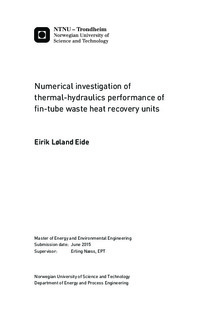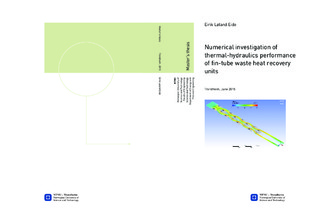| dc.description.abstract | The objective of this master thesis is to increase the understanding of fluid flow and heat transfer development across a finned tube heat exchanger with help of Computational Fluid Dynamics (CFD). Three different geometries of finned tube bundles are considered. The finned tube bundles are made similar to existing experimental test rigs at NTNU. The purpose is to present a detailed comparison of the experimental data available and the result from a numerical model. Heat transfer and pressure drop performance is compared. The results are also compared with semi-empirical correlations from the published literature.
This master thesis is a continuation of the project work. A main goal has been to expand the numerical model developed in the project work to include conjugate heat transfer. This has been successfully implemented by coupling the conduction and convection on the fins. Further a calculation method to predict the heat transfer on a row-to-row basis has been developed.
The heat transfer coefficient and the fin efficiency are compared with the experimental data at each tube row for varying turbulent Reynolds numbers. The results shows that the heat transfer is predicted fairly good, but with some deviations. Generally the heat transfer is under-predicted for the two geometries having solid fins. The numerical model over-predicts the heat transfer for the geometry having serrated fins. The pressure drop performance is compared by looking at the pressure drop from the inlet to the outlet in the finned tube bundle. Larger deviations are seen between the numerical and experimental data for the pressure drop performance. Surprisingly, the pressure drop from the numerical model seems to be in better agreement with semi-empirical correlations from the published literature.
The effects of uneven heat transfer distribution has been investigated. An uneven heat transfer distribution is first of all reflected in the fin efficiency. Fin efficiencies found from the experiments and fin efficiencies calculated from the numerical model are therefore compared to theoretical fin efficiencies and reputable corrected fin efficiencies from the literature.
A qualitative analysis is performed by investigating relevant visualizations of the flow through the finned tube bundle. This analysis revealed several important effects happening in the finned tube bundles, affecting the heat transfer. This include boundary-layer development across the fins, horseshoe vortexes at the junction of the fin and tube and flow separation downstream of the finned tube rows. It is concluded that the use of CFD have a big potential for improving the prediction of heat transfer and pressure drop in fin-tube waste heat recovery units. Suggestions for further work on how the numerical model could be expanded are presented. | |

